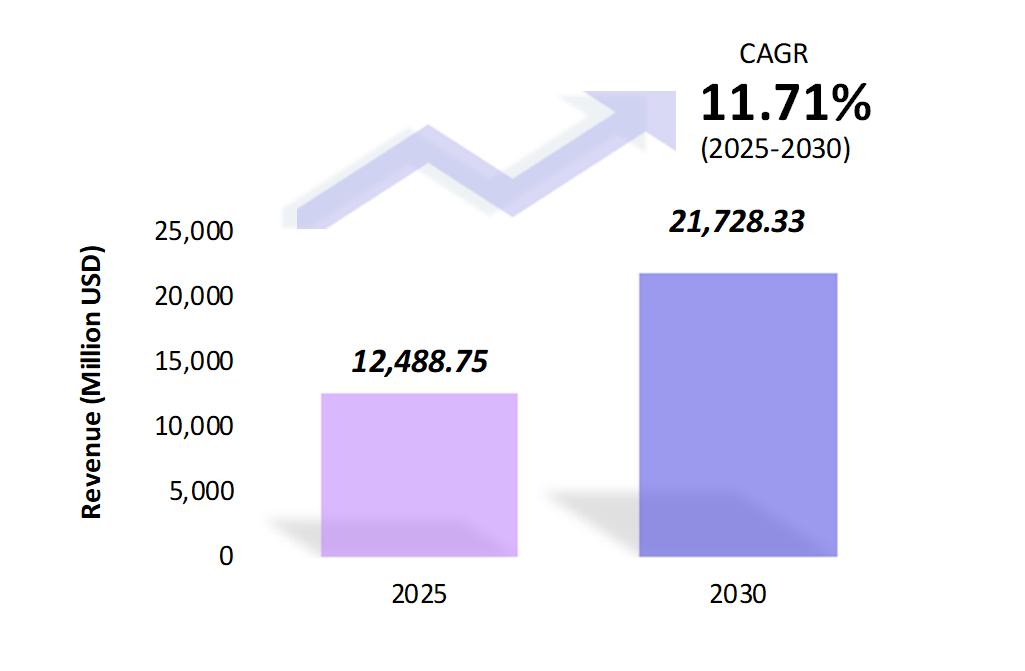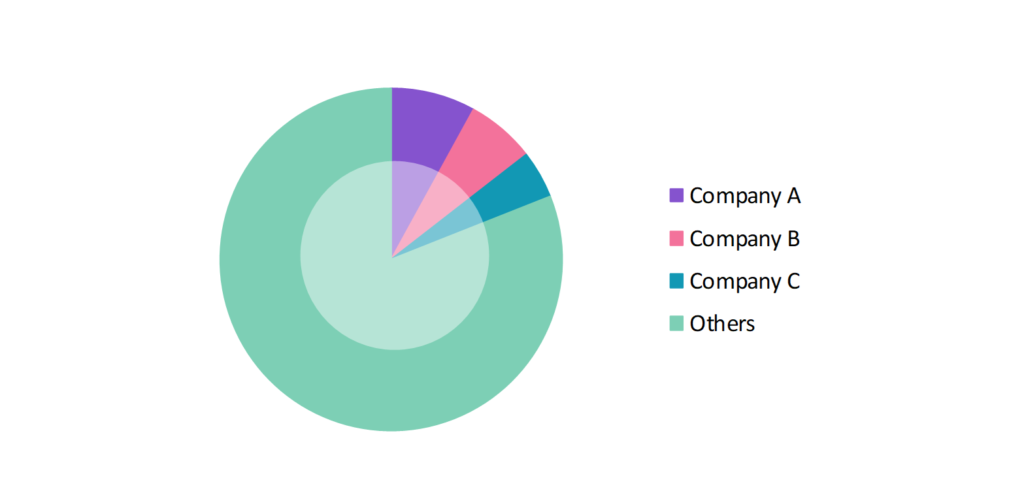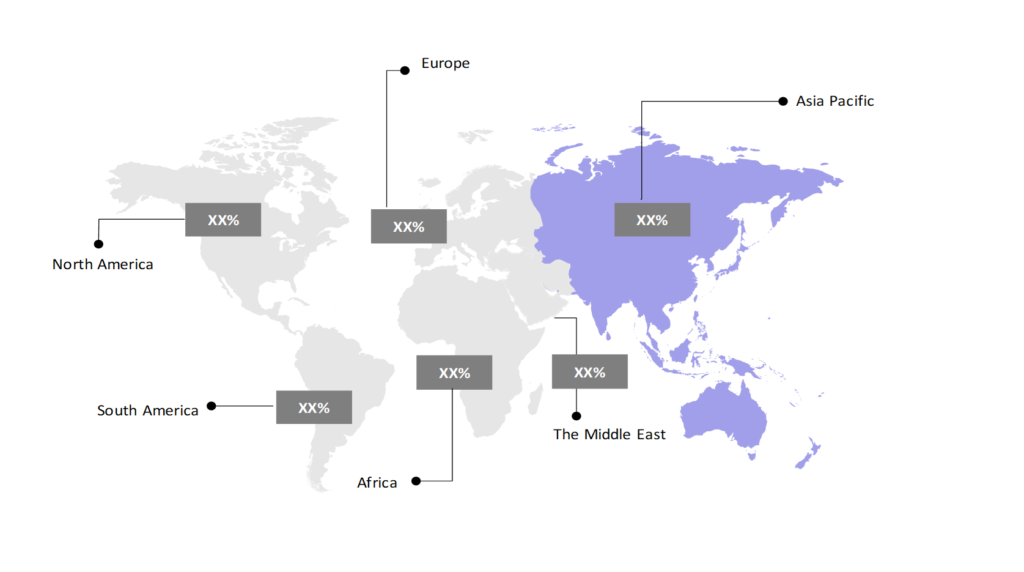Prebiotics Market Outlook: Size, Share, Trends & Growth Analysis (2024-2029)
The market report presents a thorough analysis segmented by Ingredients (Fructo-oligosaccharide (FOS), Inulin, Galacto-oligosaccharides (GOS), Mannan-oligosaccharide (MOS), Others); by Application (Prebiotic Food & Beverages, Prebiotic Dietary Supplements, Animal Feed Prebiotics); by Geography (North America, South America, Asia Pacific, Europe, The Middle East & Africa).
Outlook

- The prebiotics market is estimated to be at USD 12,488.75 Mn in 2025 and is anticipated to reach USD 21,728.33 Mn in 2030.
- The prebiotics market is registering a CAGR of 11.71% during the forecast period 2025-2030.
- Prebiotics are non-digestible fibers that promote beneficial gut bacteria growth, supporting digestive health and immunity. The global prebiotics market has grown significantly due to increasing awareness of gut health and demand for functional foods.
Request a free sample.
Ecosystem

- The participants in the global prebiotics industry are actively involved in developing innovative prebiotic products and expanding their presence in the global market.
- These companies primarily focus on product innovation along with collaborations between food & beverage manufacturers and prebiotic ingredient suppliers to maintain a competitive edge in the market.
- Several important entities in the prebiotics market include Cosun Beet Co. – Biobased Experts B.V.; Ingredion Inc.; Royal FrieslandCampina N.V.; Jarrow Formulas, Inc.; Nexira; and others.
Ask for customization.
Findings
| Attributes | Values |
|---|---|
| Historical Period | 2019-2023 |
| Base Year | 2024 |
| Forecast Period | 2025-2030 |
| Market Size (2025) | USD 12,488.75 Mn |
| Market Size (2030) | USD 21,728.33 Mn |
| Growth Rate | 11.71% CAGR from 2025 to 2030 |
| Key Segments | Ingredients (Fructo-oligosaccharide (FOS), Inulin, Galacto-oligosaccharides (GOS), Mannan-oligosaccharide (MOS), Others); Application (Prebiotic Food & Beverages, Prebiotic Dietary Supplements, Animal Feed Prebiotics); Geography (North America, South America, Asia Pacific, Europe, The Middle East & Africa) |
| Key Vendors | Abbott Laboratories; Beneo GmbH; Royal FrieslandCampina N.V.; Jarrow Formulas, Inc.; Kerry Group Plc |
| Key Countries | The US; Canada; Mexico; Brazil; Chile China; India; Japan; Australia; The UK; Germany; Italy; France; Spain; UAE; Egypt; South Africa; Saudi Arabia |
| Largest Market | Asia Pacific |
Get a free quote.
Trends
- Sustainability in Prebiotic Production: Sustainability concerns are pushing manufacturers to adopt eco-friendly production methods for prebiotics. The focus on reducing waste and sourcing prebiotic fibers from renewable resources is becoming a key trend.
- Innovation in Prebiotic Sources: Companies are exploring new sources of prebiotics, such as seaweed, mushrooms, and plant extracts, to meet the demand for more diverse and sustainable prebiotic ingredients. This trend is driven by the increasing demand for natural and plant-based health products.
- Focus on Symbiotics (Prebiotics + Probiotics): Combining prebiotics with probiotics to create symbiotic products is becoming a popular trend in the food and supplement industry. This combination enhances the efficacy of both components, leading to improved digestive health. In 2023, Danone introduced symbiotic yogurt in Europe that includes both prebiotics and probiotics, targeted at health-conscious consumers seeking enhanced gut benefits.
Speak to analyst.
Catalysts
- Increased Use of Prebiotics in Weight Management: Prebiotics are gaining popularity in weight management as they help regulate hunger hormones and improve metabolism by promoting a healthy gut microbiome. This has led to the incorporation of prebiotics into dietary supplements aimed at weight control.
- Government Support: Governments and health organizations around the world are promoting the use of prebiotics as part of a healthy diet to combat lifestyle-related diseases. Initiatives that encourage the consumption of fiber-rich foods are supporting the growth of the prebiotics market. In 2022, the European Food Safety Authority (EFSA) issued guidelines highlighting the benefits of prebiotics in promoting gut health, which contributed to the increased adoption of prebiotic ingredients in food products.
- Rising Awareness of Gut Health: Consumers are becoming more aware of the importance of gut health and its role in overall well-being, which is driving the demand for prebiotic-rich foods and supplements. This increased focus on maintaining a healthy microbiome is fueling market growth.
Inquire before buying.
Restraints
- Regulatory Hurdles: The regulatory environment for prebiotics is complex and varies by region. Stringent regulations regarding the health claims made by prebiotic products can hinder market growth, especially in regions with strict food and health safety standards.
- Limited Research on Long-Term Effects: While prebiotics are generally considered safe, there is limited research on their long-term effects, particularly in high doses. This uncertainty may deter some consumers from using prebiotics regularly, impacting market growth. In 2022, the International Scientific Association for Probiotics and Prebiotics called for more research into the long-term use of prebiotics, citing gaps in scientific understanding of their prolonged effects on the gut microbiome.
- High Production Costs of Prebiotics: The production of prebiotics, especially from natural sources, can be expensive, making prebiotic products more costly than other functional foods. The high cost of raw materials and processing limits market penetration, particularly in price-sensitive regions.
Personalize this research.
Hotspot

Explore purchase options.
Table of Contents
| 1. Introduction 1.1. Research Methodology 1.2. Scope of the Study 2. Market Overview / Executive Summary 2.1. Global Prebiotics Market (2019 – 2023) 2.2. Global Prebiotics Market (2024 – 2030) 3. Market Segmentation 3.1. Global Prebiotics Market by Ingredients 3.1.1. Fructo-oligosaccharide (FOS) 3.1.2. Inulin 3.1.3. Galacto-oligosaccharides (GOS) 3.1.4. Mannan-oligosaccharide (MOS) 3.1.5. Others 3.2. Global Prebiotics Market by Application 3.2.1. Prebiotic Food & Beverages 3.2.2. Prebiotic Dietary Supplements 3.2.3. Animal Feed Prebiotics 4. Regional Segmentation 4.1. North America 4.1.1. The US 4.1.2. Canada 4.1.3. Mexico 4.2. South America 4.2.1. Brazil 4.2.2. Argentina 4.2.3. Rest of South America 4.3. Asia Pacific 4.3.1. China 4.3.2. India 4.3.3. Japan 4.3.4. Australia 4.3.5. Rest of Asia Pacific 4.4. Europe 4.4.1. The UK 4.4.2. Germany 4.4.3. Italy 4.4.4. France 4.4.5. Spain 4.4.6. Rest of Europe 4.5. The Middle East & Africa 4.5.1. Egypt 4.5.2. South Africa 4.5.3. Saudi Arabia 4.5.4. Rest of the Middle East & Africa 5. Value Chain Analysis of the Global Prebiotics Market 6. Porter Five Forces Analysis 6.1. Threats of New Entrants 6.2. Threats of Substitutes 6.3. Bargaining Power of Buyers 6.4. Bargaining Power of Suppliers 6.5. Competition in the Industry 7. Trends, Drivers and Challenges Analysis 7.1. Market Trends 7.1.1. Market Trend 1 7.1.2. Market Trend 2 7.1.3. Market Trend 3 7.2. Market Drivers 7.2.1. Market Driver 1 7.2.2. Market Driver 2 7.2.3. Market Driver 3 7.3. Market Challenges 7.3.1. Market Challenge 1 7.3.2. Market Challenge 2 7.3.3. Market Challenge 3 8. Opportunities Analysis 8.1. Market Opportunity 1 8.2. Market Opportunity 2 8.3. Market Opportunity 3 9. Competitive Landscape 9.1. Cosun Beet Co. – Biobased Experts B.V. 9.2. Ingredion Inc. 9.3. Royal FrieslandCampina N.V. 9.4. Jarrow Formulas, Inc. 9.5. Kerry Group Plc 9.6. Company 6 9.7. Company 7 9.8. Company 8 9.9. Company 9 9.10. Company 10 |
Know the research methodology.
Prebiotics Market – FAQs
1. What is the current size of the prebiotics market?
Ans. In 2025, the prebiotics market size is USD 12,488.75 Mn.
2. Who are the major vendors in the prebiotics market?
Ans. The major vendors in the prebiotics market are Cosun Beet Co. – Biobased Experts B.V.; Ingredion Inc.; Royal FrieslandCampina N.V.; Jarrow Formulas, Inc.; Kerry Group Plc.
3. Which segments are covered under the prebiotics market segments analysis?
Ans. The prebiotics market report offers in-depth insights into Ingredients, Application, and Geography.
